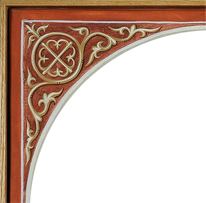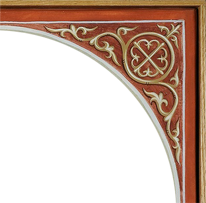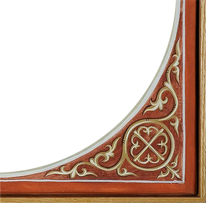Everybody instinctively longs for happiness. But often one does not know what happiness is, and searches in places where there is no happiness and where it cannot be. By His Transfiguration on Mount Tabor Lord Jesus Christ demonstrated that real happiness lies in union with God. In such union the entire essence of a human changes, or transfigures: unspeakable peace, harmony and joy settle in the soul; the intellect receives enlightenment, and all abilities of a person reach their utmost extent; the soul fills with Divine light and becomes godlike. Now the Kingdom of God enters the human.
Transfiguration of Our Saviour was a revelation of the highest grace of the Kingdom of God "coming with power." Not physical but spiritual light of Christ's Divine nature, by then hidden under the veil of His human flesh, shone on Mount Tabor. The miracle was that the scales, concealing the spiritual world, fell from the Apostles' physical eyes, and with their spiritual eyes they saw Christ in His Divine Power. Then their hearts were filled with the beatitude they had never experienced before.
Since the Holy Ghost came upon the Apostles and until today, many Christians, especially saints, have joined the Miracle of Tabor, being honored with seeing the gleams of the Divine Light. Those were always unforgettable and most happy moments of their lives. However, the Divine light is not the realm of the few chosen. First coming at the time of the Holy Baptism, it mysteriously resides in every Christian since then. It strengthens up in line with a Christian's improvement and approach to God, specifically after the Holy Communion.
For humans not to fall to laziness and pride, it is not given to them to feel the entire joy of communion with God, which shall be the reward in the world to come. Still the Divine light rests in zealous Christians, and at times Lord out of His Grace gives us to feel this special joy of communion with Him. Such communion is perceived as shining of a mysterious light inside a person. This shining brings forward the particular unforgettable bliss, inexplicable to those who have never experienced it. Compared to it, all worldly joys seem scanty and miserable. We believe that the eternal life will start after this temporary world, and 'Then shall the righteous shine forth as the sun in the kingdom of their Father' (Matt 13:43).
The Event of Transfiguration
The Transfiguration of Lord Jesus Christ on Mount Tabor, where His appearance changed and became light-like, is described by Evangelists Matthew, Mark and Luke. The Transfiguration took place six days after the Saviour had told about His forthcoming sufferings on the Cross. The Crucifixion followed in about forty days after Transfiguration. The evangelist Matthew described Our Saviour's Transfiguration as follows:
"And after six days Jesus taketh Peter, James, and John his brother, and bringeth them up into an high mountain apart, And was transfigured before them: and his face did shine as the sun, and his raiment was white as the light. And, behold, there appeared unto them Moses and Elias talking with him. Then answered Peter, and said unto Jesus, Lord, it is good for us to be here: if thou wilt, let us make here three tabernacles; one for thee, and one for Moses, and one for Elias. While he yet spake, behold, a bright cloud overshadowed them: and behold a voice out of the cloud, which said, This is my beloved Son, in whom I am well pleased; hear ye him. And when the disciples heard it, they fell on their face, and were sore afraid. And Jesus came and touched them, and said, Arise, and be not afraid. And when they had lifted up their eyes, they saw no man, save Jesus only. And as they came down from the mountain, Jesus charged them, saying, Tell the vision to no man, until the Son of man be risen again from the dead. And his disciples asked him, saying, Why then say the scribes that Elias must first come? And Jesus answered and said unto them, Elias truly shall first come, and restore all things. But I say unto you, That Elias is come already, and they knew him not, but have done unto him whatsoever they listed. Likewise shall also the Son of man suffer of them" (Matt 17:1-12).
The place of Transfiguration is not named by any of the Evangelists, but the ancient tradition unanimously points at Tabor, a mountain in Galilee, six kilometers south-east of Nazareth.
The Saviour did not bring all His disciples up to the mountain, but only three of them (Peter, James and his brother John the Theologian), while the others stayed at the foot of the mountain. Going uphill was tiring, and the Apostles accompanying Christ lied down for rest and dozed off; the Saviour started praying. During the prayer, the looks of Our Saviour changed: His face shone as the sun, and His clothes became white as the light. The bright light woke up the Apostles and they saw their Teacher in His heavenly glory of the Son of God. His Divinity shone through His flesh and clothing.
Looking at the Saviour in astonishment, the Apostles saw two unfamiliar figures who, as it turned up later, were ancient prophets Moses and Elias coming to Christ from the world invisible. The Evangelists do not explain why these two prophets came. Supposedly, the coming of the two most authoritative Old Testament righteous people was the evidence of Christ's Divinity for the Apostles and for all Jews. First of all, until that time the rumor had been widespread among common people that Jesus Christ was either Elias, or another ancient prophet risen. The appearance of Elias and Moses witnessed the absurdity of this opinion. The prophets were actually talking to Christ as Messiah and Son of God.
The appearance of the ancient prophets who had gone to the better world must convince us Christians that the life of a human does not end with death, and that the souls of those who died are not sleeping, as some sectarians erroneously teach, but are awake, living a full-scale spiritual life. Jesus Christ has power over life and death, as He says, "I have the keys of hell and of death" (Rev. 1:18).
The conversation of Moses and Elias with Christ was to encourage the Apostles and strengthen their faith in Christ when the suffering on the Cross was close ahead. The Apostles indeed thought about their Teacher's suffering as humiliation and dishonor, but the prophets called it "glory" that He intended to manifest in Jerusalem. And right before the Crucifixion the Saviour viewed the impending suffering and dishonorable death as the beginning of glorification of His Father and Himself as the Saviour of the mankind; He said, "Father, the hour is come; glorify thy Son, that thy Son also may glorify Thee" (John 17:1).
The special graceful state of the Apostles during the Saviour's Transfiguration was expressed by Saint Peter who said, "Lord, it is good for us to be here!" Delighted by the glorious vision, Peter wished that it would last, and last forever, if possible. So Peter suggested to the Saviour to make three tabernacles, or pavilions, on the top of the mountain (Jews and other oriental people made 'tabernacles' by digging a pole in the ground, stretching ropes from its top to pegs driven at a certain distance around it, and covering it with fabric; sometimes skins or leaves and bark were used instead). The Apostle Peter did not want to come back to the insidious and malicious world where his Teacher was threatened by suffering and death.
As the Evangelists say, at that moment everyone on the mountain was overshadowed by a bright cloud, which indicated the presence of God the Father (a dark cloud is symbol and sign of God the Just Judge (Ex. 24:18; 19:18), while a bright cloud is the symbol and sign of the presence of God Merciful. A similar bright cloud, called shekina in the Bible, was at times seen above the Sanctuary, the main part of the Judean temple (1 Kings 8:10-11; Ezek 1:4; 10:4), and a mysterious voice was heard from the cloud like it was during Theophany, "This is my beloved Son, in whom I am well pleased," and also, "Hear Him." These last words were to remind the Apostles of Moses' ancient prophecy of the forthcoming Great Prophet Who would herald God's will to the Jews. "Whosoever will not hearken unto my words which he shall speak in my name, I will require it of him," says God in Deuteronomy 18:19. So here on Tabor fifteen hundred years later God Father gave the evidence of Moses' prophesy about the Messiah as the Greatest of prophets.
Hearing the voice from the cloud, the disciples fell on the ground in fear. Everything was unusual for them here on the mountain: the seclusion and height of the place, the deep silence of nature, the appearance of the prophets of the past, the light of extreme brightness and finally the voice of God Father Himself.
When they were coming down, Jesus forbade the Apostles to tell anyone what had happened on the mountain until His rising from the dead. The Lord transfigured in order to affirm to His trusted disciples that He indeed was the Messiah. Still it was too early to tell about the Transfiguration to the Jewish public at large whose senses would anticipate the Messiah as a powerful king and conqueror. One of the eye witnesses of this event, Apostle Peter, later recalled it as unquestionably trustworthy and brought it forth as proof of Christ's divine nature (2 Peter 1:16-18).
So, on Mount Tabor Lord Jesus Christ demonstrated the Kingdom of God with power, giving the Apostles the joy of communion with God. By His Transfiguration on Mount Tabor the Lord calls us for a new life, to internal transfiguration which would make us meek out of proud, diligent out of idle, sober out of passionate, temperate out of greedy, concentrated out of absent-minded, God-obedient out of self-willed, compassionate out of heartless.
As much as soul is more precious than body, thus much internal, spiritual light is more important than external, physical light; and vice versa, internal, spiritual darkness is more dangerous, dreadful and disastrous than darkness of night or blindness. He who loses internal vision, altogether loses the everlasting life with God, of which light is a part, as well as it is a part of the corporal life.
Divine light resides in everyone since baptism. For a human not to be proud and lazy, God does not give him to feel the shining of internal light all the time. But still this light dwells inside the person's soul, increased by moral perfection, ardent prayer at church and at home, reading of the Holy Scripture, thinking about God, doing good works, and especially by receiving the Holy Communion. It is dangerous to artificially invoke and try to see the shining of spiritual light. This may lead to being caught in the devilish net. Clear vision of this light may be given rarely, when God finds it necessary to give consolation and support to a Christian.
Internal effect of this light is felt in peacefulness of soul, disgust for any sin, love for God and neighbors, desire to live for the good, strongly believe and trust God, long for the Kingdom of Heaven. Let us treasure the Kingdom of God inside us so that God would grant us eternal life in the Kingdom of Never-ending Light. Amen.



